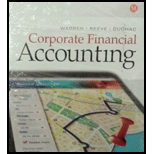
Costco, Walmart, Nordstrom: Inventory turnover and number of days’ sales in inventory
The general merchandise retail industry has a number of segments represented by the following companies:
| Company Name | Merchandise Concept |
| Costco Wholesale Corporation | Membership warehouse |
| Walmart Stores, Inc. | Discount general merchandise |
| Nordstrom, Inc. | Fashion department store |
For a recent year, the following cost of goods sold and beginning and ending inventories are provided from corporate annual reports (in millions) for these three companies:
| Costco | Walmart | Nordstrom | |
| Cost of goods sold | $98,458 | $365,086 | $8,406 |
| Inventories: | |||
| Beginning of year | 7,894 | 44,858 | 1,531 |
| End of year | 8,456 | 45,141 | 1,733 |
A. Determine the inventory turnover ratio for all three companies. (Round all calculations to one decimal place.)
B. Determine the number of days’ sales in inventory for all three companies. (Use 365 days and round all calculations to one decimal place.)
C. Interpret these results based on each company’s merchandising concept.
(a)
Inventory turnover ratio: Inventory turnover ratio is used to determine the number of times inventory used or sold during the particular accounting period. The formula to calculate the inventory turnover ratio is as follows:
Days’ sales in inventory: Days’ sales in inventory are used to determine number of days a particular company takes to make sales of the inventory available with them. The formula to calculate the days’ sales in inventory ratio is as follows:
the inventory turnover for Company C, Company W and Company N
Answer to Problem 6.2ADM
The inventory turnover ratio for Company C is calculated is calculated as follows:
The inventory turnover ratio for Company W is calculated is calculated as follows:
The inventory turnover ratio for Company N is calculated is calculated as follows:
Explanation of Solution
The inventory turnover ratio is calculated by dividing cost of goods sold by average inventory during the period. The average inventory is calculating by dividing beginning inventory and ending inventory by 2. The inventory turnover ratio is an important measure as to how efficient is the management is good at managing inventory and achieving sales from it. Working notes:
The average inventory is calculated as follows:
Working notes:
The average inventory is calculated as follows:
Working notes:
The average inventory is calculated as follows:
The inventory turnover of Company C is 12.0 Times, the inventory turnover of Company W is 8.1 Times & the inventory turnover of Company N is 5.2 Times.
(b)
the Days’ sales in inventory ratio for Company C, Company W and Company N.
Answer to Problem 6.2ADM
The Days’ sale in inventory ratio for Company C is calculated is calculated as follows:
The Days’ sales in inventory ratio for Company W is calculated are calculated as follows:
The Days’ sales in inventory ratio for Company N is calculated are calculated as follows:
Explanation of Solution
The Days’ sales in inventory ratio are calculated by dividing days in accounting period by inventory turnover ratio. The Days’ sale in inventory ratio is an important measure to know how long the company is holding the inventory before selling when compared to its peers.
The Days’ sales in inventory of Company C is 30.3 days, the Days’ sales in inventory of Company W is 45.0 days, & the Days’ sales in inventory of Company N is 71.0 days.
(c)
To interpret: the above calculated ratios.
Explanation of Solution
The inventory turnover ratio and number of days’ sales in inventory of all the three companies reflect the merchandising approaches of all companies. Company C is a club warehouse and it has approach of holding only items which are quickly sold. Most of the items are sold in bulk at very attractive prices.
In case of company W, it has a traditional discounter approach. Even though it has attractive pricing, the inventory movement is slower than in the case of company C.
In the case of company N, it is a high-end fashioner retailer. It offers a wide collection of specialty and unique goods that are specifically designed for fashion market rather than for general mass market. Therefore, the movement is slower than other two companies yet it has highest margin.
Want to see more full solutions like this?
Chapter 6 Solutions
Bundle: Corporate Financial Accounting, Loose-leaf Version, 14th + LMS Integrated for CengageNOWv2, 1 term Printed Access Card
- Please provide the correct answer to this general accounting problem using valid calculations.arrow_forwardI need help with this financial accounting problem using proper accounting guidelines.arrow_forwardPlease explain the solution to this financial accounting problem with accurate principles.arrow_forward
 Financial And Managerial AccountingAccountingISBN:9781337902663Author:WARREN, Carl S.Publisher:Cengage Learning,
Financial And Managerial AccountingAccountingISBN:9781337902663Author:WARREN, Carl S.Publisher:Cengage Learning, Financial AccountingAccountingISBN:9781305088436Author:Carl Warren, Jim Reeve, Jonathan DuchacPublisher:Cengage Learning
Financial AccountingAccountingISBN:9781305088436Author:Carl Warren, Jim Reeve, Jonathan DuchacPublisher:Cengage Learning Financial AccountingAccountingISBN:9781337272124Author:Carl Warren, James M. Reeve, Jonathan DuchacPublisher:Cengage Learning
Financial AccountingAccountingISBN:9781337272124Author:Carl Warren, James M. Reeve, Jonathan DuchacPublisher:Cengage Learning Cornerstones of Financial AccountingAccountingISBN:9781337690881Author:Jay Rich, Jeff JonesPublisher:Cengage Learning
Cornerstones of Financial AccountingAccountingISBN:9781337690881Author:Jay Rich, Jeff JonesPublisher:Cengage Learning College Accounting, Chapters 1-27AccountingISBN:9781337794756Author:HEINTZ, James A.Publisher:Cengage Learning,
College Accounting, Chapters 1-27AccountingISBN:9781337794756Author:HEINTZ, James A.Publisher:Cengage Learning, Managerial Accounting: The Cornerstone of Busines...AccountingISBN:9781337115773Author:Maryanne M. Mowen, Don R. Hansen, Dan L. HeitgerPublisher:Cengage Learning
Managerial Accounting: The Cornerstone of Busines...AccountingISBN:9781337115773Author:Maryanne M. Mowen, Don R. Hansen, Dan L. HeitgerPublisher:Cengage Learning





